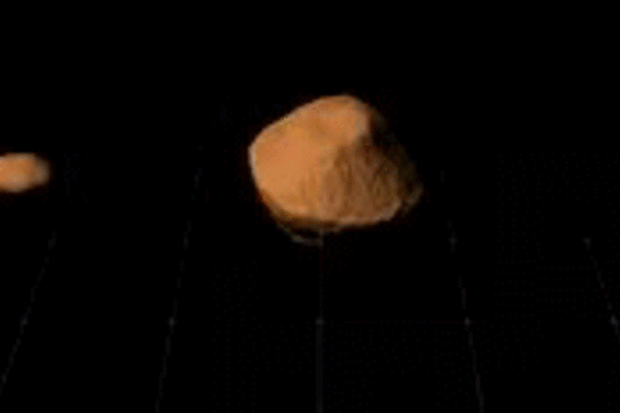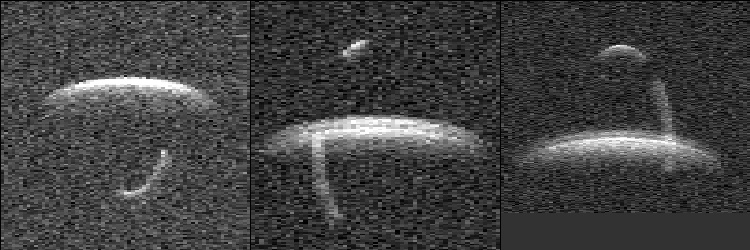An Asteroid with Its Own Moon Will Zip Past Earth Tonight

A very big asteroid with its own little moon is going to zip past Earth tonight (May 25) — close enough that, with some preparation and a decent telescope, amateur astronomers may spot it blotting out the stars.
This moon-and-asteroid system, called 1999 KW4, is made up of two rocks. The big one is about 0.8 miles (1.3 kilometers) wide, according to NASA, and shaped like a spinning top. The smaller one is more elongated and stretches 0.35 miles (0.57 km) along its longest dimension. It points lengthwise toward its much larger twin.
Together, the asteroid and its minimoon will pass Earth at such a strange, steep angle that NASA called them "the least accessible … for a spacecraft mission of any known binary near-Earth asteroid." [Doomsday: 9 Real Ways Earth Could End]
But that doesn't mean they aren't interesting to look at.
The two asteroids will pass closest to Earth at 7:05 pm EDT (1105 GMT), when they'll be just 3,219,955 miles (5,182,015 km) from the planet's surface. That's more than a dozen times the distance between the Earth and the moon in its orbit around our planet, and much too far for the space rocks to pose any threat. In fact, this is the fourth approach the binary asteroids have made toward Earth since they were discovered in 1999, and not the closest. This is not the first time, according to EarthSky, that astronomers plan to make radar images of these asteroids as they pass.

Back on May 25, 2001, according to NASA, the asteroids passed about 6.7% closer to Earth than they will this time, at a distance of 3,005,447 miles (4,836,798 km). Seventeen years from now, on May 25, 2036, the rocks will pass 55.2% closer to Earth, at a distance of just 1,443,511 miles (2,323,106 km) — again, posing no threat worth worrying about.
These big rocks have been frequent flyers in our planet's neighborhood for a long time.
Sign up for the Live Science daily newsletter now
Get the world’s most fascinating discoveries delivered straight to your inbox.
"1999 KW4 approaches within 0.05 AU of Earth several times each century," NASA's report on the object said. "This trend exists from at least [the year] 1600 [to] 2500." [Black Marble Images: Earth at Night]
"AU" refers to "astronomical units," a unit equal to the distance between Earth and the sun. So 0.05 AU is equal to one-twentieth the distance between Earth and sun, or about 4,650,000 miles (7,480,000 km). The two asteroids have passed even closer to Earth, without incident, several times a century since William Shakespeare was writing, and they will continue to do so until this article is at least 500 years old.
EarthSky reported that during the space rocks' closest approach, they'll be most visible in the Southern Hemisphere, appearing as fast-moving shadows against stars in the constellation Puppis. The two asteroids will remain visible for several days, though, according to EarthSky. North American asteroid hunters may spot the objects near the constellation Hydra on the evening of May 27.
NASA said that its Planetary Defense Coordination Office will continue to closely monitor the asteroids.
- Images: Russian Meteor Explosion
- Top 10 Ways to Destroy Earth
- Crash! 10 Biggest Impact Craters on Earth
Originally published on Live Science.










